Feasible Reserve in Day-Ahead Unit Commitment Using Scenario-Based Optimization
Abstract
:1. Introduction
- The partitioned step PSO (PSPSO), which can handle the dynamic changes in solution limits by making sure that some particles re-search the solution space through the incorporation of the adaptive concept, and through partitioning the step equation to increase the collaboration between particles;
- An extended model for the UC problem to determine much faster the feasible generator limit, feasible reserve, and time constraint parameters;
- A study on the effect of the feasible reserve and conventional computation solution on deterministic and scenario-based approach solutions, considering uncertainty in load and/or generation.
2. Problem Formulation
2.1. System Model
2.2. Scenario Generation and Reduction
2.3. Mathematical Model
2.4. Extended Model
2.4.1. Time Constraints
2.4.2. Feasible Generator Limits
2.5. Reserve Cases
3. Partitioned Step Particle Swarm Optimization
4. Data and Results
4.1. Unit Commitment
4.1.1. Costs
4.1.2. Losses
4.1.3. Committed Units
4.1.4. Hourly Reserve
4.2. Test for Robustness
4.2.1. Deterministic Cases
4.2.2. Scenario-Based Cases
5. Discussion
6. Conclusions
Author Contributions
Funding
Conflicts of Interest
References
- Solar, Wind Power Generation Hits New High in Taiwan. Taiwan Today. 17 April 2018. Available online: https://taiwantoday.tw/news.php?unit=6&post=132786 (accessed on 17 April 2018).
- Lee, A.H.I.; Chen, H.H.; Chen, J. Building smart grid to power the next century in Taiwan. Renew. Sustain. Energy Rev. 2017, 68, 126–135. [Google Scholar] [CrossRef]
- Ngitevelekwa, K.; Bansal, R. A review of generation dispatch with large-scale photovoltaic systems. Renew. Sustain. Energy Rev. 2018, 81, 615–624. [Google Scholar] [CrossRef]
- Notton, G.; Nivet, M.L.; Voyant, C.; Paoli, C.; Darras, C.; Motte, F.; Fouilloy, A. Intermittent and stochastic character of renewable energy sources: Consequences, cost of intermittence and benefit of forecasting. Renew. Sustain. Energy Rev. 2018, 87, 96–105. [Google Scholar] [CrossRef]
- Lappalainen, K.; Valkealahti, S. Output power variation of different PV array configurations during irradiance transitions caused by moving clouds. Appl. Energy 2017, 190, 902–910. [Google Scholar] [CrossRef]
- Abujarad, S.; Mustafa, M.; Jamian, J. Recent approaches of unit commitment in the presence of intermittent renewable energy resources: A review. Renew. Sustain. Energy Rev. 2017, 70, 215–223. [Google Scholar] [CrossRef]
- Theo, W.L.; Lim, J.S.; Ho, W.S.; Hashim, H.; Lee, C.T. Review of distributed generation(DG) system planning and optimization techniques: Comparison of numerical and mathematical modelling methods. Renew. Sustain. Energy Rev. 2017, 67, 531–573. [Google Scholar] [CrossRef]
- Saber, N.A.; Salimi, M.; Mirabbasi, D. A priority list based approach for solving thermal unit commitment problem with novel hybrid genetic-imperialist competitive algorithm. Energy 2016, 117, 272–280. [Google Scholar] [CrossRef]
- Srikanth, K.; Panwar, L.K.; Panigrahi, B.K.; Herrera-Viedma, E.; Sangaiah, A.K.; Wang, G.G. Meta-heuristic framework: Quantum inspired binary grey wolf optimizer for unit commitment problem. Comput. Electr. Eng. 2017, 70, 243–260. [Google Scholar] [CrossRef]
- Panwar, L.; Reddy, S.; Verma, A.; Panigrahi, B.K.; Kumar, R. Binary grey wolf optimizer for large scale unit commitment problem. Swarm Evol. Comput. 2018, 38, 251–266. [Google Scholar] [CrossRef]
- Quan, H.; Srinivasan, D.; Khosravi, A. Integration of renewable generation uncertainties into stochastic unit commitment considering reserve and risk: A comparative study. Energy 2016, 103, 735–745. [Google Scholar] [CrossRef]
- Shukla, A.; Singh, S. Multi-objective unit commitment with renewable energy using hybrid approach. IET Renew. Power Gener. 2016, 3, 327–338. [Google Scholar] [CrossRef]
- Hedayati-Mehdiabadi, M.; Hedman, K.; Zhang, J. Reserve Policy Optimization for scheduling wind energy and reserve. IEEE Trans. Power Syst. 2018, 1, 19–31. [Google Scholar] [CrossRef]
- Soltani, Z.; Ghaljehei, M.; Gharehpetian, G.B.; Aalami, H.A. Integration of smart grid technologies in stochastic multi-objective unit commitment: An economic emission analysis. Int. J. Electr. Power Energy Syst. 2018, 100, 565–590. [Google Scholar] [CrossRef]
- Ye, H.; Wang, J.; Ge, Y.; Li, J.; Li, Z. Robust integration of high-level dispatchable renewables in power system operation. IEEE Trans. Sustain. Energy 2017, 2, 826–835. [Google Scholar] [CrossRef]
- Pandzic, H.; Dvorkin, Y.; Qiu, T.; Wang, Y.; Kirschen, D.S. Toward cost-efficient and reliable unit commitment under uncertainty. IEEE Trans. Power Syst. 2016, 2, 970–981. [Google Scholar] [CrossRef]
- Zhang, Y.; Wang, J.; Ding, T.; Wang, X. Conditional value at risk-based stochastic unit commitment considering the uncertainty of wind power generation. IET Gener. Trans. Distrib. 2018, 2, 482–489. [Google Scholar] [CrossRef]
- Zhang, Y.; Wang, J.; Zeng, B.; Hu, Z. Chance-Constrained Two-stage Unit Commitment under uncertain Load and Wind Power Output Using Bilinear Benders Decomposition. IEEE Trans. Power Syst. 2017, 5, 3637–3647. [Google Scholar] [CrossRef] [Green Version]
- Shi, Z.; Liang, H.; Dinavahi, V. Data-driven distributionally robust chance-constrained unit commitment with uncertain wind power. IEEE Access 2019, 7, 135087–135098. [Google Scholar] [CrossRef]
- Shao, C.; Wang, X.; Shahidehpour, M.; Wang, X.; Wang, B. Security-constrained unit commitment with flexible uncertainty set for variable wind power. IEEE Trans. Sustain. Energy 2017, 3, 1237–1246. [Google Scholar] [CrossRef]
- Khatami, R.; Parvania, M.; Narayan, A. Flexibility reserve in power systems: Definition and stochastic multi-fidelity optimization. IEEE Trans. Smart Grid 2019, 11, 644–654. [Google Scholar] [CrossRef]
- Alizadeh, M.I.; Moghaddam, M.P.; Amjady, N. Multistage multiresolution robust unit commitment with nondeterministic flexible ramp considering load and wind variables. IEEE Trans. Sustain. Energy 2018, 2, 872–883. [Google Scholar] [CrossRef]
- Parvania, M.; Scaglione, A. Unit commitment with continuous-time generation and ramping trajectory models. IEEE Trans. Power Syst. 2016, 4, 3169–3178. [Google Scholar] [CrossRef]
- Khatami, R.; Parvania, M. Continuous-time locational marginal price of energy. IEEE Access 2019, 7, 129480–129493. [Google Scholar] [CrossRef]
- Blanco, I.; Morales, J. An efficient robust solution to the two-stage stochastic unit commitment problem. IEEE Trans. Power Syst. 2017, 6, 4477–4488. [Google Scholar] [CrossRef] [Green Version]
- Bruninx, K.; Delarue, E. Endogenous probabilistic reserve sizing and allocation in unit commitment models: Cost effective, reliable and fast. IEEE Trans. Power Syst. 2017, 4, 2593–2603. [Google Scholar] [CrossRef]
- NASA. Surface Meteorology and Solar Energy. Available online: https//eosweb.larc.nasa.gov/cgi-bin/sse/retscreen.cgi?email=skip%40larc.nasa.gov&step=1&lat=24.77&lon=121.04&submit=Submit (accessed on January 2018).
- Han, H.-G.; Lu, W.; Hou, Y.; Qiao, J.-F. An Adaptive-PSO-Based Self-Organizing RBF Neural Network. IEEE Trans. Neural Netw. Learn. Syst. 2018, 29, 104–117. [Google Scholar] [CrossRef] [PubMed]
- Bonyadi, M.R.; Michalewicz, Z. Analysis of stability, local convergence, and transformation sensitivity of a variant of the particle swarm optimization algorithm. IEEE Trans. Evol. Comput. 2016, 3, 370–385. [Google Scholar] [CrossRef] [Green Version]
- Liang, J.J.; Qin, A.K.; Suganthan, P.N.; Baskar, S. Comprehensive learning particle swarm optimizer for global optimization of multimodal functions. IEEE Trans. Evol. Comput. 2006, 3, 281–295. [Google Scholar] [CrossRef]
- Li, Y.; Zhan, Z.H.; Lin, S.; Zhang, J.; Luo, X. Competitive and cooperative particle swarm optimization with information sharing mechanism for global optimization problems. Inf. Sci. 2015, 293, 370–382. [Google Scholar] [CrossRef]
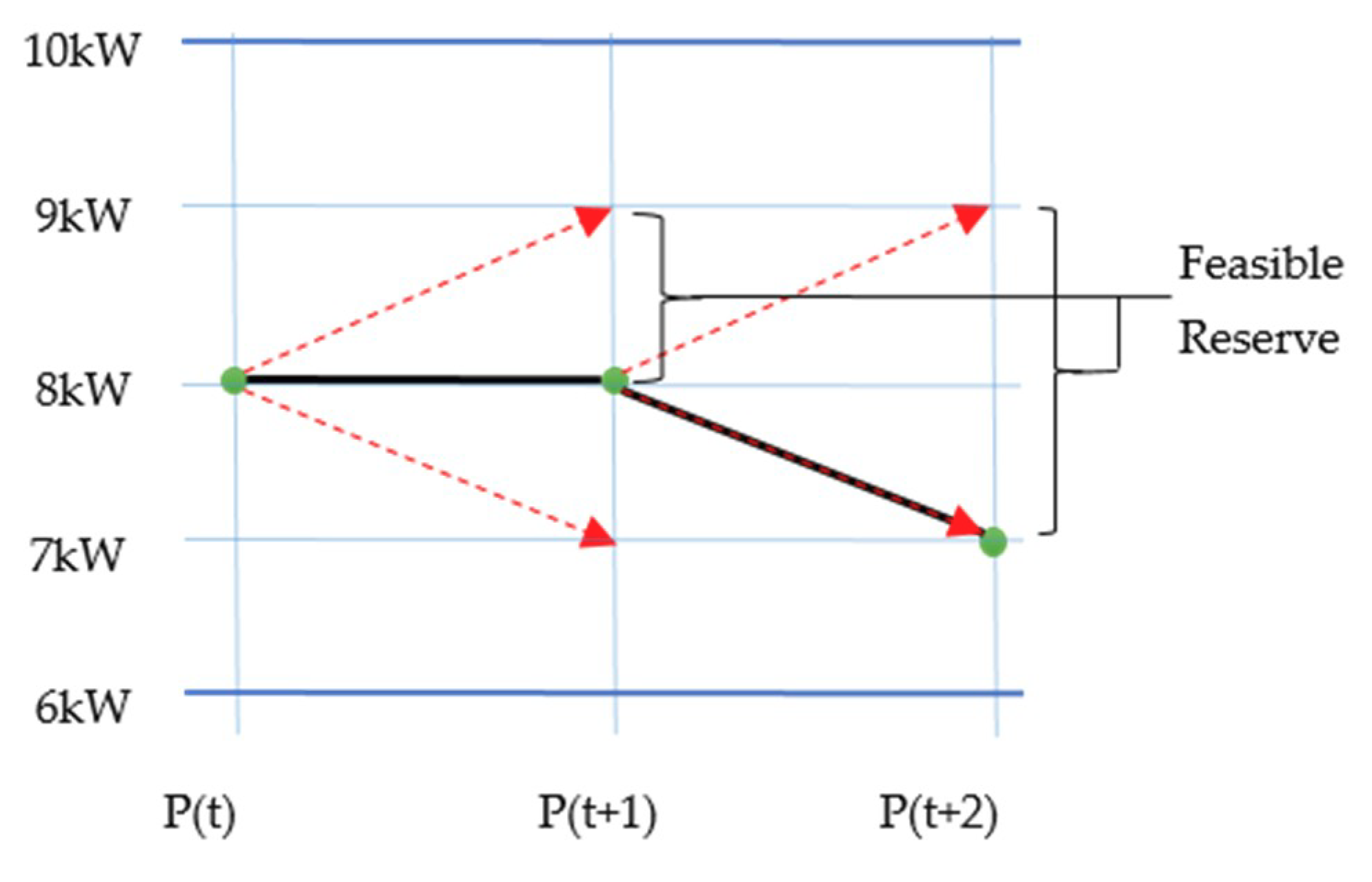
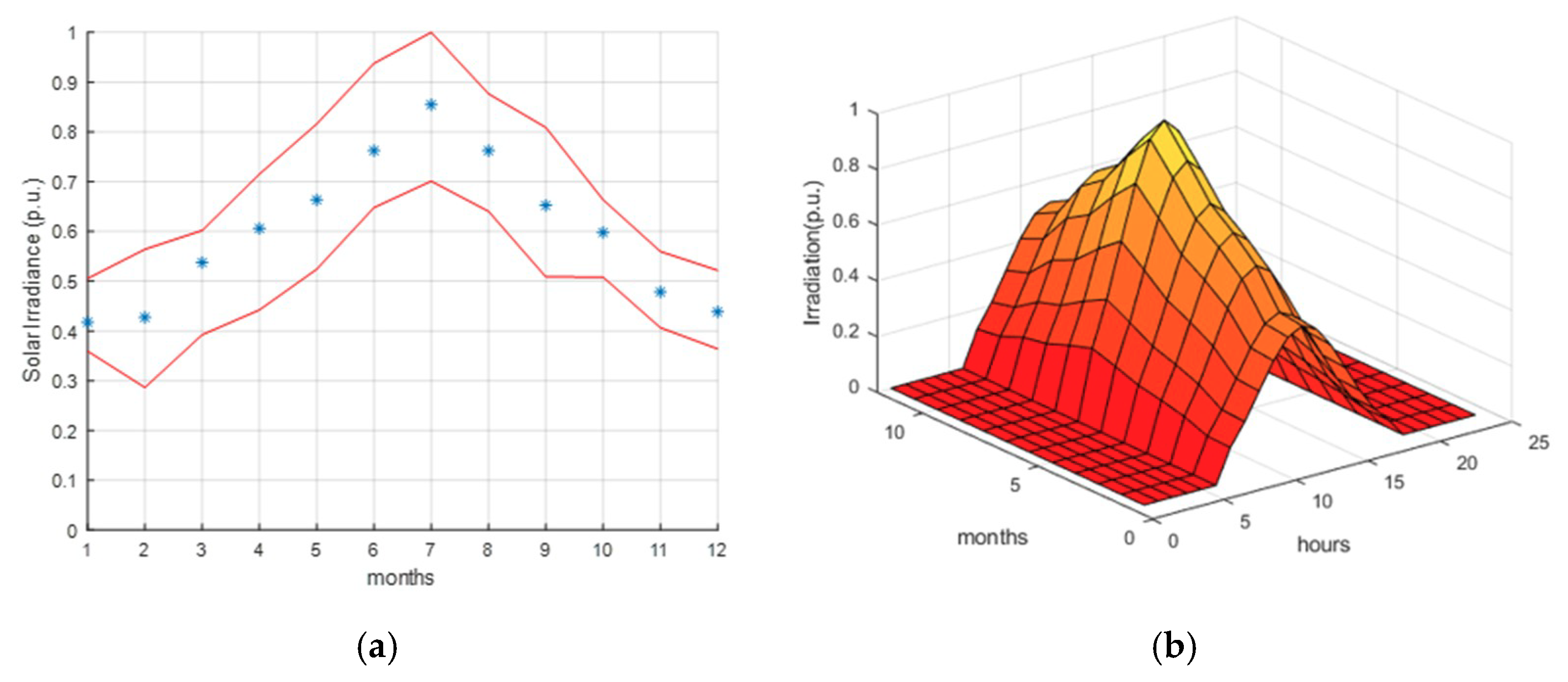
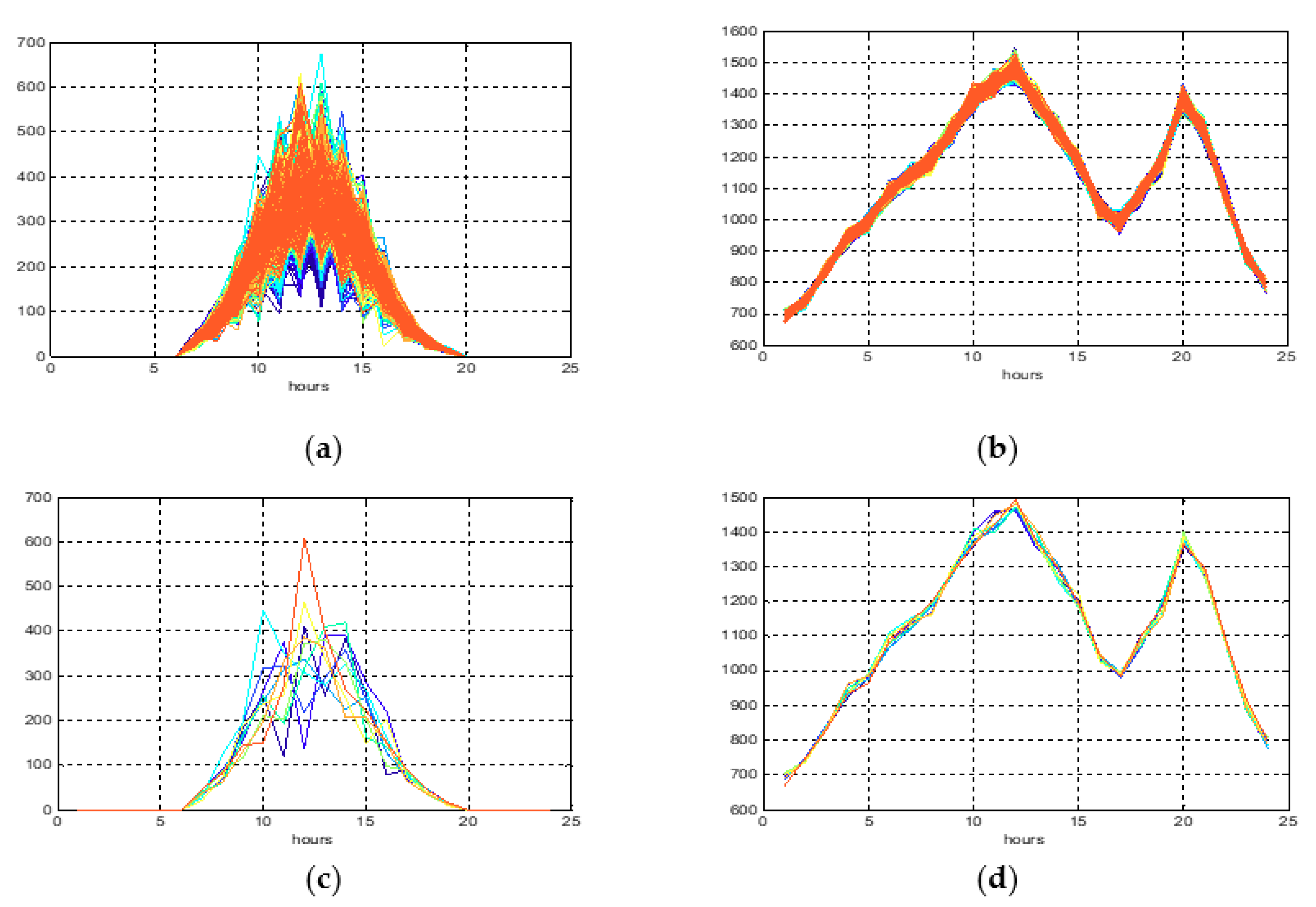
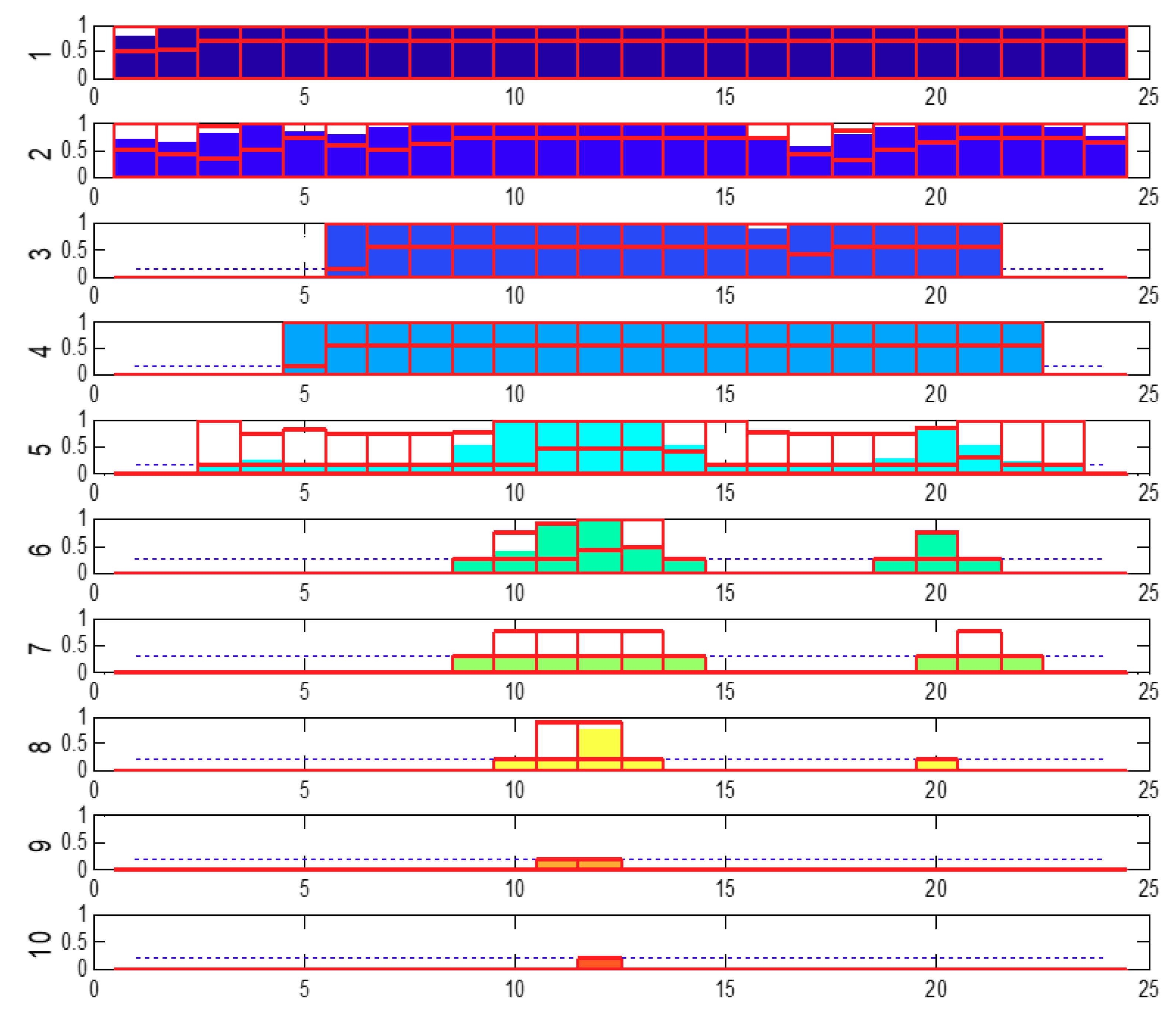
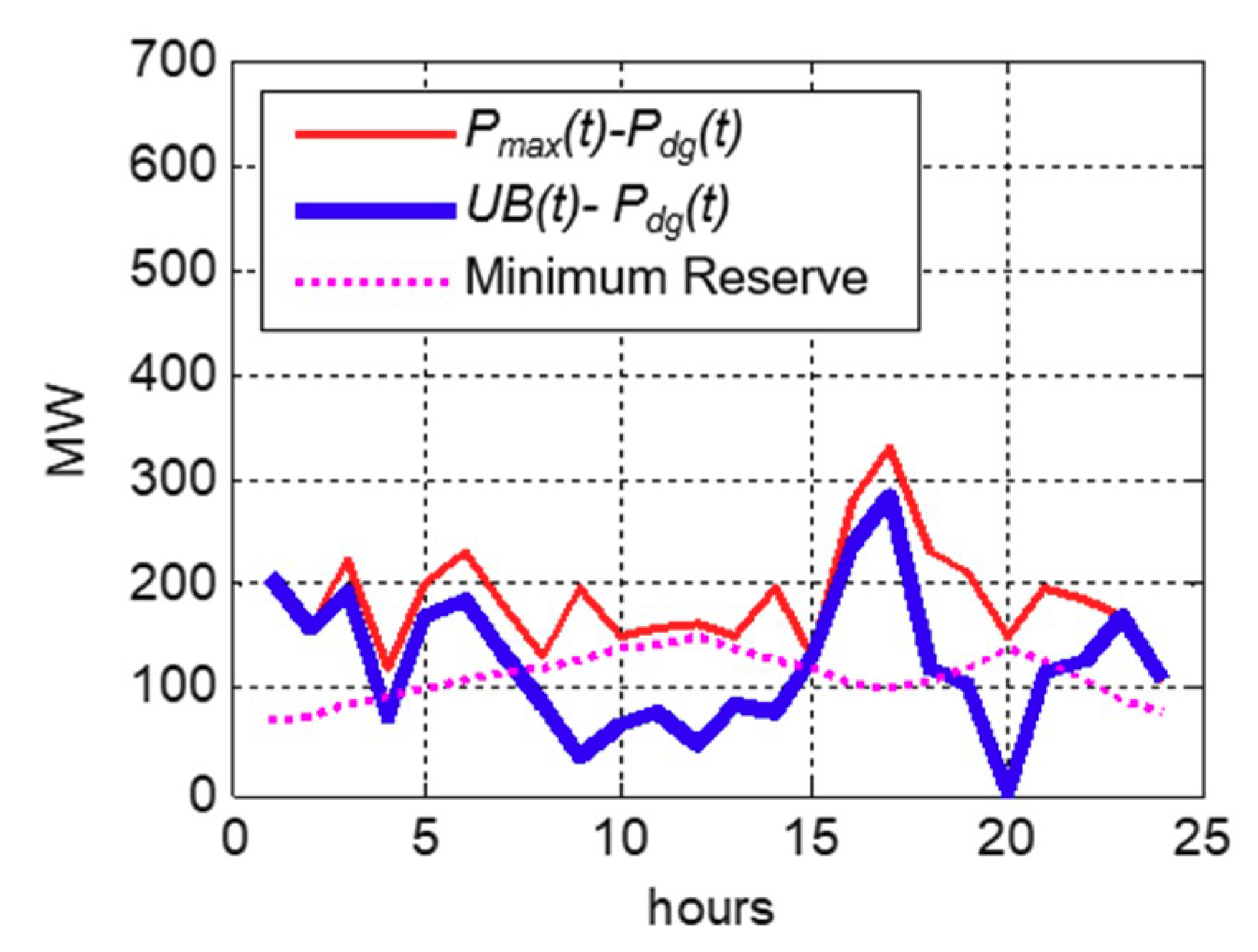
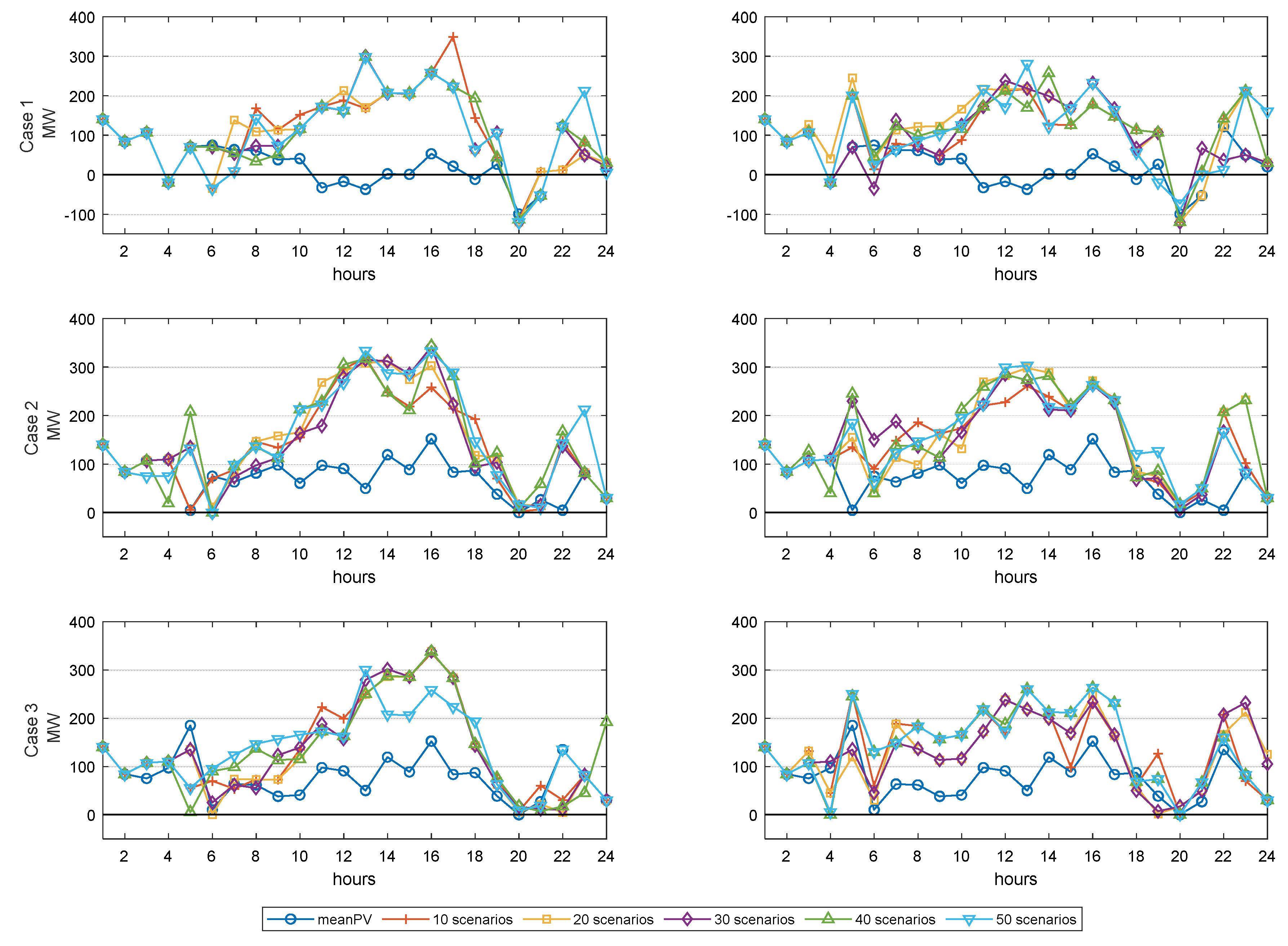
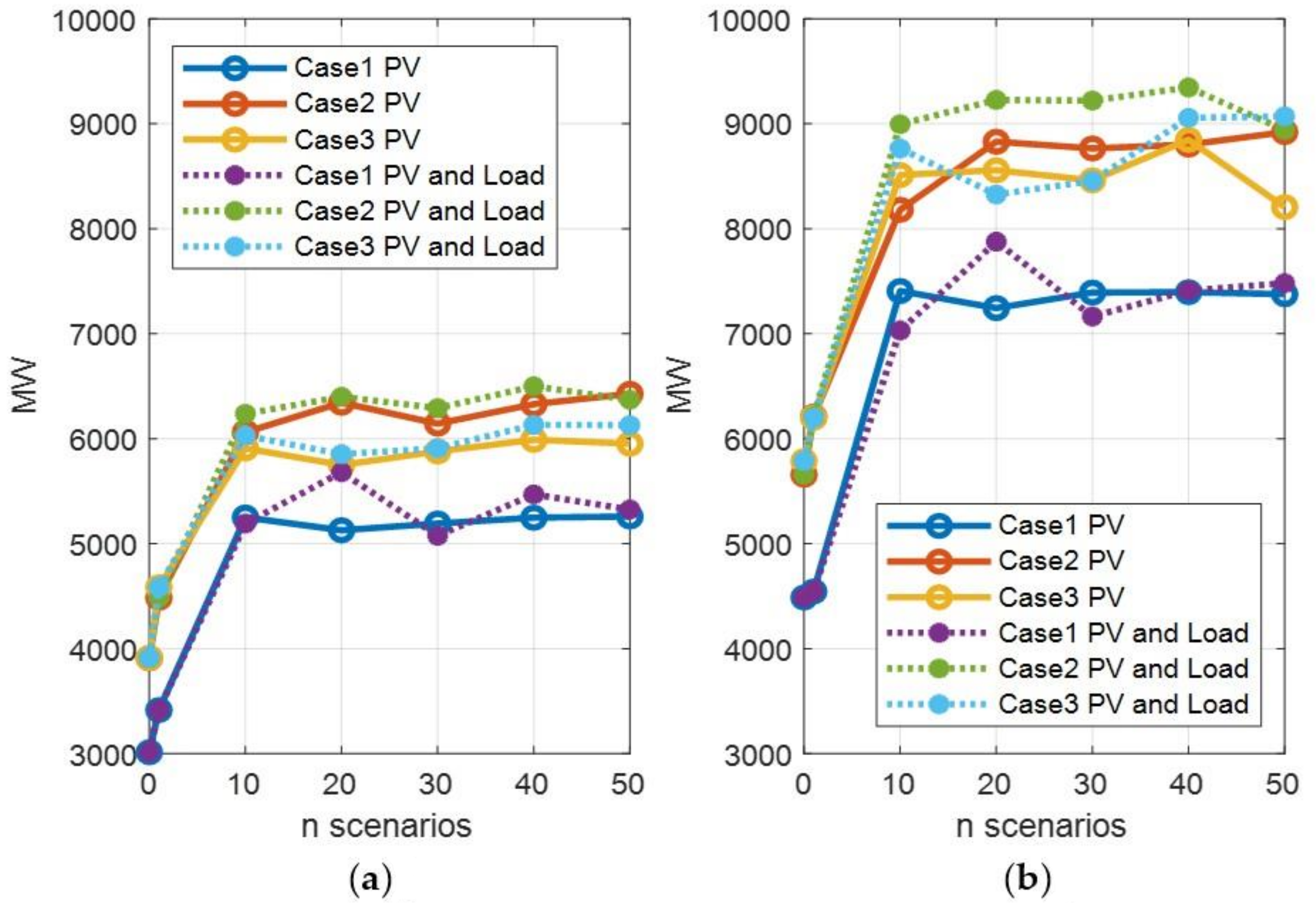
| Time (hr) | 0 | 1 | 2 | 3 | 4 | 5 | 6 |
|---|---|---|---|---|---|---|---|
| UCp | 0 | 0 | 1 | 1 | 1 | 0 | 1 |
| UC | 0 | 1 | 1 | 1 | 0 | 1 | 0 |
| UCn | 1 | 1 | 1 | 0 | 1 | 0 | 0 |
| p | 1 | 0 | 0 | 0 | 1 | 0 | 0 |
| q | 0 | 1 | 0 | 0 | 0 | 1 | 0 |
| r | 0 | 0 | 0 | 1 | 0 | 1 | 0 |
| u | 0 | 0 | 0 | 0 | 1 | 0 | 1 |
| v | 0 | 0 | 1 | 1 | 0 | 0 | 0 |
| w | 0 | 1 | 0 | 0 | 0 | 0 | 0 |
| Case 1 | no PV | mean PV | Number of PV Scenarios | Number of PV and Load Scenarios | |||||||||
|---|---|---|---|---|---|---|---|---|---|---|---|---|---|
| 10 | 20 | 30 | 40 | 50 | 10 × 10 | 20 × 20 | 30 × 30 | 40 × 40 | 50 × 50 | ||||
| Fuel Cost | 560,325 | 484,791 | 528,822 | 528,283 | 528,751 | 528,843 | 529,023 | 548,146 | 548,344 | 548,450 | 548,075 | 548,899 | |
| Start-Up | 4090 | 4590 | 4040 | 4030 | 4030 | 4040 | 4040 | 4040 | 3310 | 4030 | 4040 | 3480 | |
| ENS | 0 | 0 | 0 | 0 | 0 | 0 | 0 | 0 | 0 | 0 | 0 | 4 | |
| RES | 0 | 0 | 0 | 0 | 0 | 0 | 0 | 0 | 0 | 0 | 0 | 62 | |
| Total | 564,415 | 489,381 | 532,862 | 532,313 | 532,781 | 532,883 | 533,063 | 552,186 | 551,654 | 552,480 | 552,115 | 552,445 | |
| Case 2 | |||||||||||||
| Fuel Cost | 573,017 | 495,047 | 534,354 | 535,891 | 535,596 | 535,776 | 537,189 | 552,396 | 553,589 | 552,742 | 553,493 | 553,087 | |
| Start-Up | 3600 | 4430 | 4150 | 3050 | 2990 | 2990 | 2990 | 2990 | 2990 | 3050 | 2820 | 2990 | |
| ENS | 0 | 0 | 0 | 0 | 0 | 0 | 0 | 0 | 0 | 0 | 0 | 0 | |
| RES | 0 | 0 | 0 | 0 | 0 | 166 | 192 | 16 | 40 | 45 | 307 | 89 | |
| Total | 576,617 | 499,477 | 538,504 | 538,941 | 538,586 | 538,932 | 540,371 | 555,402 | 556,619 | 555,837 | 556,620 | 556,167 | |
| % of C1* | 2.16% | 2.06% | 1.06% | 1.24% | 1.09% | 1.14% | 1.37% | 0.58% | 0.90% | 0.61% | 0.82% | 0.67% | |
| Case 3 | |||||||||||||
| Fuel Cost | 573,667 | 494,791 | 534,674 | 535,104 | 534,807 | 535,420 | 533,803 | 551,789 | 550,516 | 552,264 | 552,176 | 552,377 | |
| Start-Up | 3600 | 3540 | 3540 | 2990 | 2990 | 3540 | 4090 | 3280 | 3830 | 3540 | 2990 | 2990 | |
| ENS | 0 | 0 | 0 | 0 | 0 | 0 | 0 | 0 | 0 | 0 | 0 | 0 | |
| RES | 0 | 0 | 0 | 0 | 0 | 0 | 0 | 0 | 0 | 0 | 0 | 0 | |
| Total | 577,267 | 498,331 | 538,214 | 538,094 | 537,797 | 538,960 | 537,893 | 555,069 | 554,346 | 555,804 | 555,166 | 555,367 | |
| % of C1* | 2.28% | 1.83% | 1.00% | 1.09% | 0.94% | 1.14% | 0.91% | 0.52% | 0.49% | 0.60% | 0.55% | 0.53% | |
| UC Method and Reserve Case | DA Cost | OTD Cost | % Increase in Costs | ||||
|---|---|---|---|---|---|---|---|
| Fuel | SU | ENS | RNS | Total | |||
| High Uncertainties | |||||||
| DUC-C1 | 489,380 | 544,232 | 4590 | 448,000 | 403,700 | 1,400,522 | 186.18% |
| DUC-C2 | 499,477 | 551,569 | 4430 | 10,500 | 124,300 | 690,799 | 38.30% |
| DUC-C3 | 498,330 | 551,122 | 3540 | 10,500 | 124,300 | 689,462 | 38.35% |
| SUC-C1-PV | 532,861 | 550,137 | 4040 | 0 | 0 | 554,177 | 4.00% |
| SUC-C2-PV | 538,504 | 552,585 | 4150 | 0 | 0 | 556,735 | 3.39% |
| SUC-C3-PV | 538,214 | 554,131 | 3540 | 0 | 0 | 557,671 | 3.62% |
| SUC-C1-PVL | 552,186 | 548,755 | 4040 | 0 | 0 | 552,795 | 0.11% |
| SUC-C2-PVL | 555,401 | 552,724 | 2990 | 0 | 0 | 555,714 | 0.06% |
| SUC-C3-PVL | 555,068 | 552,020 | 3280 | 0 | 0 | 555,300 | 0.04% |
| Medium-High Uncertainties | |||||||
| DUC-C1 | 489,380 | 542,182 | 4590 | 696,500 | 279,400 | 1,522,672 | 211.14% |
| DUC-C2 | 499,477 | 550,013 | 4430 | 0 | 143,000 | 697,443 | 39.63% |
| DUC-C3 | 498,330 | 550,595 | 3540 | 0 | 143,000 | 697,135 | 39.89% |
| SUC-C1-PV | 532,861 | 548,940 | 4040 | 0 | 0 | 552,980 | 3.78% |
| SUC-C2-PV | 538,504 | 551,584 | 4150 | 0 | 0 | 555,734 | 3.20% |
| SUC-C3-PV | 538,214 | 553,371 | 3540 | 0 | 0 | 556,911 | 3.47% |
| SUC-C1-PVL | 552,186 | 548,000 | 4040 | 0 | 0 | 552,040 | −0.03% |
| SUC-C2-PVL | 555,401 | 551,322 | 2990 | 0 | 0 | 554,312 | −0.20% |
| SUC-C3-PVL | 555,068 | 550,866 | 3280 | 0 | 0 | 554,146 | −0.17% |
| Medium Uncertainties | |||||||
| DUC-C1 | 489,380 | 543,424 | 4590 | 0 | 172,700 | 720,714 | 47.27% |
| DUC-C2 | 499,477 | 547,659 | 4430 | 0 | 0 | 552,089 | 10.53% |
| DUC-C3 | 498,330 | 548,125 | 3540 | 0 | 0 | 551,665 | 10.70% |
| SUC-C1-PV | 532,861 | 546,253 | 4040 | 0 | 0 | 550,293 | 3.27% |
| SUC-C2-PV | 538,504 | 549,942 | 4150 | 0 | 0 | 554,092 | 2.89% |
| SUC-C3-PV | 538,214 | 551,370 | 3540 | 0 | 0 | 554,910 | 3.10% |
| SUC-C1-PVL | 552,186 | 544,757 | 4040 | 0 | 0 | 548,797 | −0.61% |
| SUC-C2-PVL | 555,401 | 549,636 | 2990 | 0 | 0 | 552,626 | −0.50% |
| SUC-C3-PVL | 555,069 | 548,996 | 3280 | 0 | 0 | 552,276 | −0.50% |
| Low Uncertainties | |||||||
| DUC-C1 | 489,380 | 540,796 | 4590 | 0 | 40,700 | 586,086 | 19.76% |
| DUC-C2 | 499,477 | 545,330 | 4430 | 0 | 0 | 549,760 | 10.07% |
| DUC-C3 | 498,330 | 544,911 | 3540 | 0 | 16,500 | 564,951 | 13.37% |
| SUC-C1-PV | 532,861 | 544,201 | 4040 | 0 | 0 | 548,241 | 2.89% |
| SUC-C2-PV | 538,504 | 546,749 | 4150 | 0 | 0 | 550,899 | 2.30% |
| SUC-C3-PV | 538,214 | 548,243 | 3540 | 0 | 0 | 551,783 | 2.52% |
| SUC-C1-PVL | 552,186 | 541,983 | 4040 | 0 | 0 | 546,023 | −1.12% |
| SUC-C2-PVL | 555,401 | 546,179 | 2990 | 0 | 0 | 549,169 | −1.12% |
| SUC-C3-PVL | 555,068 | 545,747 | 3280 | 0 | 0 | 549,027 | −1.09% |
© 2020 by the authors. Licensee MDPI, Basel, Switzerland. This article is an open access article distributed under the terms and conditions of the Creative Commons Attribution (CC BY) license (http://creativecommons.org/licenses/by/4.0/).
Share and Cite
Ocampo, E.; Huang, Y.-C.; Kuo, C.-C. Feasible Reserve in Day-Ahead Unit Commitment Using Scenario-Based Optimization. Energies 2020, 13, 5239. https://doi.org/10.3390/en13205239
Ocampo E, Huang Y-C, Kuo C-C. Feasible Reserve in Day-Ahead Unit Commitment Using Scenario-Based Optimization. Energies. 2020; 13(20):5239. https://doi.org/10.3390/en13205239
Chicago/Turabian StyleOcampo, Erica, Yen-Chih Huang, and Cheng-Chien Kuo. 2020. "Feasible Reserve in Day-Ahead Unit Commitment Using Scenario-Based Optimization" Energies 13, no. 20: 5239. https://doi.org/10.3390/en13205239






